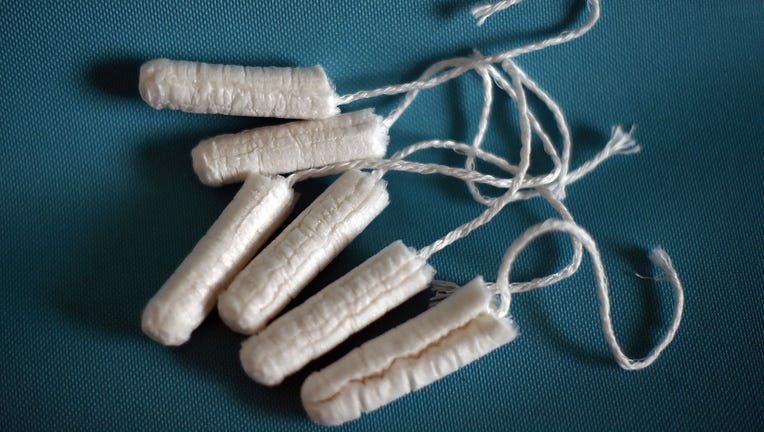Tampons can contain toxic metals like lead and arsenic, study finds

FILE. (Photo by Loic Venance/AFP via Getty Images)
Researchers from the University of California, Berkeley say they found 16 types of metals while testing tampons, including toxic metals like lead and arsenic.
Thirty tampons from 14 brands and 18 product lines available in the U.S. and Europe were evaluated in the experiment.
Researchers found various concentrations across all tampons of all 16 metals they were looking for:
- Arsenic
- Barium
- Calcium
- Cadmium
- Cobalt
- Chromium
- Copper
- Iron
- Manganese
- Mercury
- Nickel
- Lead
- Selenium
- Strontium
- Vanadium
- Zinc
Several of these metals are considered toxic, including lead, cadmium, arsenic, chromium and mercury. Researchers noted the presence of chromium and mercury was found less often and in less concentrations than lead, cadmium and arsenic, and reminded that there is no "safe" exposure level to lead.
The fact that these metals were found in tampon products is concerning because the vaginal lining allows for easier absorption. Chronic metal absorption can lead to detrimental health issues, as seen in the Flint water crisis, for example, which caused prolonged exposure to lead through the drinking water.
Between 52–86% of people who menstruate in the United States use tampons, according to the study.
RELATED: Cannabis hyperemesis syndrome: Marijuana-linked condition on the rise
The tampons tested were from multiple manufacturers, brands, product lines and absorbencies, including ones marketed as "best sellers" and store-brand products. They were purchased between September 2022 - March 2023 from stores in New York City, Athens and London, as well as from two major online retailers that were not named.
The study noted tampons can come to contain metals for several reasons, including production and manufacturing. Raw materials in tampons, such as cotton, rayon, or viscose, can become contaminated through water or soil. Metals may also be intentionally added to tampons during manufacturing for various purposes, such as odor control, coloring or lubrication.
The tampons tested were made in several different countries, with the largest number made in the U.S.
Notably, researchers detected differences in most metals in non-organic tampons versus organic tampons, which were made of 100% cotton.
"For example, As (arsenic) may be more abundant in 100% organic cotton products because of the application of natural fertilizers in organic cotton fields," researchers said.
RELATED: Study suggests this free activity can reduce lower back pain
Lead in tampons
"Concerningly, we found Pb (lead) in all the tested tampons," researchers said.
"There is no safe exposure level to Pb; any proportion of Pb that may leach out of a tampon and reach systemic circulation might contribute to negative health outcomes. Pb is stored in bones, where it replaces Ca (calcium), and can be retained in the body for decades."
Other toxic metals found in greater concentrations were arsenic and cadmium, both of which can also cause adverse health effects.
How long to wear a tampon?
According to the FDA, change each tampon every 4-8 hours – and never wear a single tampon for more than 8 hours at a time.
Tampon alternatives
Several tampon alternatives are available on the market, with the most common or well-known being pads.
Period underwear and menstrual cups are also popular alternatives.
This story was reported from Detroit.

